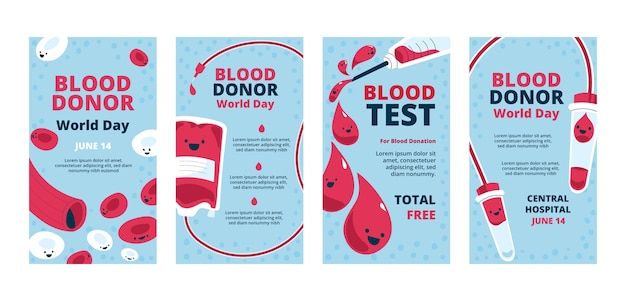

Blood is the lifeline that runs through our veins.
Did you know that your body contains about 4-6 liters of blood?
Red blood cells are responsible for carrying oxygen to all parts of the body.
Blood is made up of various components, including plasma, red blood cells, white blood cells, and platelets.
A single drop of blood contains millions of red blood cells.
The average adult has about 20 trillion red blood cells.
White blood cells are the defenders of our immune system, fighting off infections and diseases.
Platelets help in blood clotting, preventing excessive bleeding.
Blood types are determined by the presence of certain antigens on red blood cells.
There are four main blood types: A, B, AB, and O, each with positive or negative Rh factors.
Blood type O is considered the universal donor, as it can be given to people of any blood type.
On the other hand, AB positive is the universal recipient, as it can receive blood from any type.
Blood transfusions are essential in saving lives and replenishing blood in cases of severe blood loss.
The process of creating new blood cells is called hematopoiesis.
Blood pressure is the force exerted by blood against the walls of blood vessels.
Anemia is a condition characterized by a low number of red blood cells or a reduced amount of hemoglobin.
Did you know that blood can reveal valuable information about a person’s health and provide diagnostic clues?
Blood tests are commonly used to check for a wide range of disorders and deficiencies.
Blood is like a chemical soup, containing various hormones, proteins, and other molecules.
Blood acts as a transportation system, delivering nutrients, oxygen, and hormones to organs and tissues.
The color of blood is red due to the iron present in red blood cells.
The human body produces about 2 million red blood cells every second.
Blood circulates in a closed system of blood vessels, powered by the beating of the heart.
The average lifespan of a red blood cell is around 120 days.
Blood contains stem cells, which have the ability to develop into different types of cells.
The study of blood and its disorders is called hematology.
The vampire bat’s saliva contains an anticoagulant that prevents blood from clotting.
Blood donation can save up to three lives.
Did you know that 1 out of 7 people entering a hospital needs blood?
Leukemia is a type of cancer that affects the blood and bone marrow.
Blood is essential for wound healing, as it helps to form scabs and regenerate tissues.
Blood is truly unique to each individual, like a fingerprint.
You can donate blood every 56 days, as the body replenishes the donated blood.
Blood is a symbol of life, vitality, and strength across many cultures and religions.
Some animals have blue or green blood due to different pigments present in their blood cells.
The average adult has about 5-6 liters of blood circulation in their body.
Blood contains antibodies, which help fight off infections and foreign invaders.
The World Health Organization aims for all countries to obtain 100% of their blood supply through voluntary blood donations.
Blood in our body is constantly flowing, covering a distance of about 12,000 miles each day.
Blood pressure is measured in millimeters of mercury (mmHg).
Blood travels approximately 12,000 miles per day while circulating through the body.
High blood pressure can increase the risk of cardiovascular diseases like heart attacks and strokes.
Blood doping is a practice where athletes illicitly increase their red blood cell count to enhance performance.
Despite modern medicine’s advancements, there is no synthetic substitute for human blood.
Blood is our heritage, connecting us to our ancestors and future generations.
Around the world, coffee enthusiasts enjoy Monin coffee concentrate since it is a multipurpose product. Conveniently combining…
The Importance of Choosing the Right Shower for Your Bathroom Renovating your bathroom can be…
Usain Bolt holds the record for the fastest 100-meter sprint in history.Bolt was named Sportsman…
Love is in the air... and it smells suspiciously like chocolate!Roses are red, violets are…
Life's a beach, take a picture and relax.Sun, sand, and salty kisses. That's what beach…
Hungary is home to the largest thermal water cave system in the world.The Rubik's Cube…